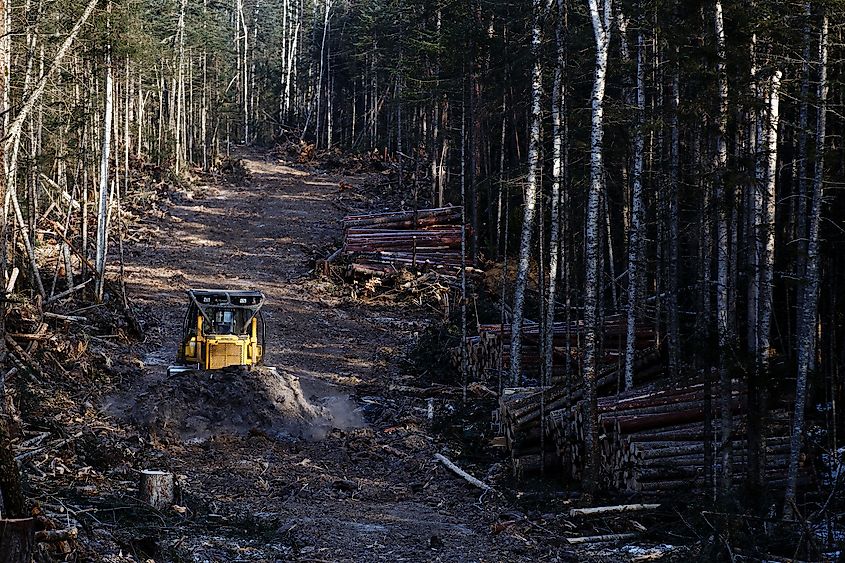Innocent-looking Logging Roads Render Siberian Tigers Vulnerable To Poaching

A scientific study published in April 2020 in Science Advances alerted the world about the dire impact of Asia's booming road network on the continent's tiger population. According to it, 24,000 km of new roads are to be built in Asia's tiger conservation landscapes or TCL's across the continent's 13 tiger range countries by 2050. Such expansion of roads would cut off tiger populations from each other and also make tigers and their prey more vulnerable to death by poaching, vehicular collisions, etc. Tiger experts in India and Nepal were certainly concerned about the negative impacts of growing linear infrastructural facilities on the tiger populations in their respective countries. But what about the Siberian tigers in Russia? To know how roads threaten Russia's tiger populations, World Atlas spoke with Anton Semyonov, Roads Project Manager, ANO WCS-Russia.
A Tiger With A Large Home Range

According to WCS-Russia, the Siberian or Amur tiger is today surviving in only a fragment of its former range. It was once widespread across the vast expanses of the Russian Far East, Northeast China, Korean Peninsula, and even parts of Northeast Mongolia. Today, only around 350 to 400 adults and 100 cubs of this tiger subspecies struggle to remain alive in the wild in the boreal and temperate mixed forests in southern Khabarovsky Krai and Primorsky Krai of Russia. There is also a tiny wild population of about 15 to 20 Amur tigers living in the forests bordering Russia and Northeast China. The wild Siberian tigers also have a much larger home range than other subspecies of tigers. A male Siberian tiger's territory size can be up to 2000 square km while females need around 250 to 450 square km area to successfully raise their young.
"Because prey densities are naturally lower in this northern realm, Siberian tigers must range over much larger areas, making almost all protected areas too small to support a viable population. Therefore, a large percentage (perhaps 60-70%) of Amur tigers live outside protected areas across a single large contiguous forest of approximately 155,000 km2. If the Amur tiger is to survive, this forested habitat must remain intact," said Anton Semyonov.
Logging Roads Are Lethal To Siberian Tigers

Given their requirements of such vast territories, does land fragmentation by building roads pose a major threat to this subspecies of tiger as proposed in the above-mentioned study?
"The Asia-wide study on the adverse impacts of roads focused mainly on the construction of major highways that act to impede the movement of tigers and fragment populations of tigers. There are virtually no major road construction projects of this sort in the Russian Far East. Hence, the problem is not highways but logging roads that are increasing in density and expanding access to what was once remote, safe havens for tigers and their prey," informed Semyonov.
"In Russia, the roads themselves are not a problem as tigers actually use forest roads as travel corridors. The problem is in how people use the roads for the illegal harvest of timber and poaching of prey and tigers themselves. These roads have increased in density some 20 times in the past 30 years, making all wildlife much more vulnerable to poaching," he continued.
According to Semyonov, these logging roads are needed by the timber industry as clear-cutting in not practiced in the Russian Far East. Instead, selective cutting removes a small proportion of standing trees, leaving the forest still present and productive for tigers and prey. However, this approach comes at a cost. An ever-growing network of logging roads is needed to support this activity.
"The logging itself is not a major threat, but the roads that are needed to provide access to the loggers are deadly to the tigers," said Semyonov.
"Unfortunately, existing Russian Forestry Codes do not provide timber companies the right to close down logging roads after they are done harvesting an area, making it difficult for these companies to protect their leases from illegal logging and poaching," he further mentioned.
Vehicular Collisions Are Less Documented
So while heightened poaching due to increased accessibility becomes a fatal trap for Siberian tigers, the death of these tigers from vehicular collisions is rare.
"Collisions with vehicles do happen, but they are rare events. They generally have little impact on the health and number of tigers and their prey. Unfortunately, there was a fatal collision this year on February 15th, 2020. A one-year-old tiger was struck and killed by an inter-city bus in northern Primorye. There are also numerous cases of ungulates (major tiger prey) being hit by vehicles, but there are no federal or regional statistics on this," said Semyonov.
Will Roads Create A Roadblock For Siberian Tigers In The Future?

"Improvements in the road network is ongoing, but in general the network of highways and access roads are not a major obstacle to the movement of Siberian tigers, unlike that in countries like India. The busiest highway in the region, linking the cities of Vladivostok and Khabarovsk, is largely in marginal tiger habitat so the threat there is low. Our problem is a different, more insidious one. A single logging road looks like it would have no impact on tigers, but the way people use these roads collectively makes them deadlier than major highways," said Semyonov.
So, what are the ways to mitigate the issue?
WCS-Russia recommends the following actions to improve logging road management:
- Changes to the Forest Code of the Russian Federation that allow timber companies to decommission roads after use, and encourage timber companies to ‘close’ roads as a means to reduce illegal logging. However, only the Russian government can make changes to the Forest Code.
- Identify logging road networks that are particularly important to tigers and prey, and work with logging companies to limit vehicular access to roads (movement on foot is always open and a right of all Russian citizens).
- Increase knowledge and understanding of the conservation problems surrounding logging road networks to increase support for changes.











